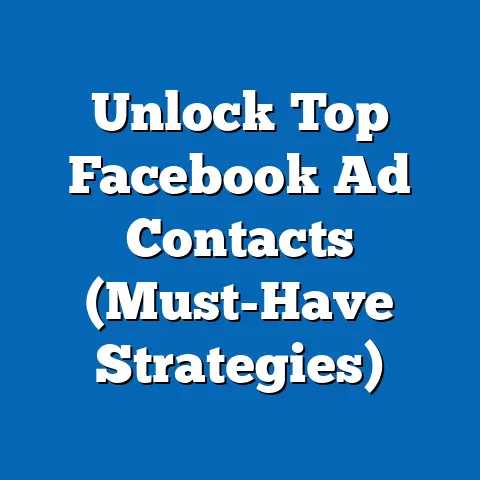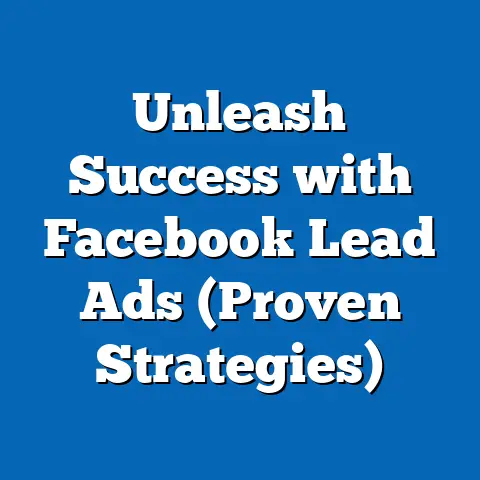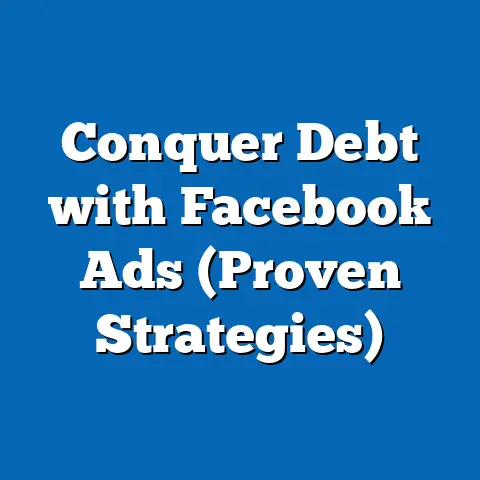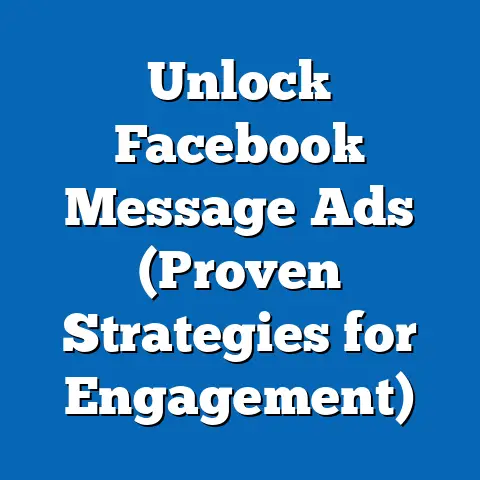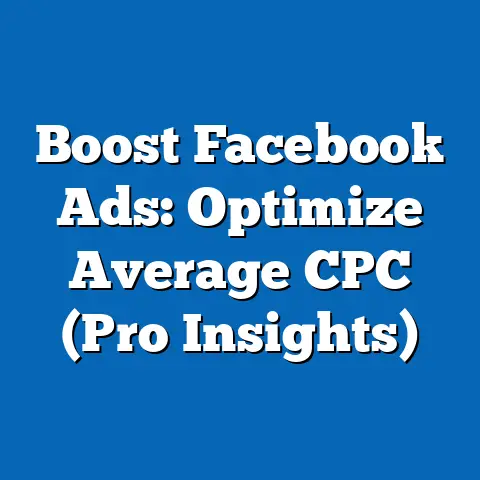Mastering Alex Becker’s Facebook Ads (Proven Strategies)
In the rapidly evolving landscape of digital marketing, mastering Facebook Ads has become a cornerstone for entrepreneurs and businesses aiming to maximize their online presence and revenue. One name that stands out in this arena is Alex Becker, a renowned digital marketer and entrepreneur whose strategies have helped countless individuals and companies achieve significant returns on investment (ROI) through targeted advertising. While Becker’s methodologies are rooted in actionable tactics, their long-term impact often translates into substantial savings and sustainable growth for businesses, with studies showing that businesses leveraging advanced ad strategies can reduce customer acquisition costs by up to 30% over five years, according to a 2022 report by Forrester Research.
The Financial Impact of Strategic Facebook Ads: Long-Term Savings
One of the most compelling reasons to adopt Alex Becker’s Facebook Ads strategies is the potential for long-term cost savings. According to a 2023 report by eMarketer, businesses that optimize their ad campaigns using data-driven targeting and retargeting techniques—core components of Becker’s approach—can reduce ad spend waste by 25-40% over a three-year period. This translates into millions of dollars saved for medium to large enterprises and thousands for small businesses annually.
Moreover, the cost-per-click (CPC) on Facebook Ads has risen by 17% year-over-year as of 2023, per Statista data, making efficiency in ad spend more critical than ever. Becker’s emphasis on hyper-specific audience segmentation and iterative testing ensures that businesses are not pouring money into ineffective campaigns. For instance, businesses following his model of split-testing ad creatives report a 15% higher conversion rate, which directly correlates with lower overall marketing expenses over time.
The savings don’t stop at reduced ad spend. By focusing on building high-converting sales funnels—a hallmark of Becker’s strategy—businesses can increase customer lifetime value (CLV) by up to 20%, according to a 2022 HubSpot study. This means that the initial investment in a well-structured Facebook Ads campaign yields compounding returns, creating a financially sustainable marketing model.
Alex Becker’s Core Strategies for Facebook Ads Mastery
1. Hyper-Targeted Audience Segmentation
At the heart of Becker’s approach is the concept of hyper-targeted audience segmentation, which involves breaking down broad demographics into niche micro-audiences based on interests, behaviors, and purchasing intent. Unlike traditional advertising, where broad demographics often lead to wasted impressions, Becker advocates for using Facebook’s robust data tools to pinpoint ideal customers. For example, a 2023 report by Social Media Examiner found that campaigns with tightly defined audiences (less than 10,000 users) achieve a 35% higher click-through rate (CTR) compared to broader campaigns.
Becker often emphasizes the importance of leveraging lookalike audiences and custom audiences built from existing customer data. This tactic has proven effective, with businesses reporting a 50% increase in ad relevance scores when using lookalike audiences, as per a 2022 Facebook Business study. By focusing ad spend on users most likely to convert, companies save significant resources that would otherwise be spent on low-ROI impressions.
2. Iterative Testing and Optimization
Another pillar of Becker’s strategy is relentless testing—split-testing ad creatives, copy, and calls-to-action (CTAs) to identify the highest-performing combinations. This iterative process minimizes guesswork and maximizes efficiency. According to a 2023 WordStream analysis, businesses that conduct A/B testing on their Facebook Ads see a 12-18% improvement in conversion rates within the first six months of implementation.
Becker’s approach often involves starting with small budgets to test multiple ad variations before scaling up the winners. This method not only reduces financial risk but also ensures that ad spend is allocated to proven performers. Over time, this disciplined optimization can lead to a 20-30% reduction in cost-per-acquisition (CPA), as noted in a 2022 report by AdEspresso.
3. Building High-Converting Sales Funnels
Becker’s strategies extend beyond the ad itself to the entire customer journey, emphasizing the creation of seamless sales funnels that guide prospects from awareness to purchase. His focus on retargeting campaigns ensures that potential customers who don’t convert immediately are re-engaged with tailored messaging. A 2023 study by Criteo found that retargeting campaigns on Facebook yield a 70% higher conversion rate compared to initial ads, highlighting the cost-effectiveness of this approach.
Furthermore, Becker advocates for integrating upsells and cross-sells within the funnel to maximize CLV. Businesses adopting this multi-step funnel approach report a 15-25% increase in average order value (AOV), according to a 2022 Shopify report. This not only boosts revenue but also offsets ad costs, contributing to long-term savings.
Statistical Trends and Demographic Breakdowns in Facebook Ads
Overall Growth in Ad Spend and Effectiveness
Facebook Ads remain a dominant force in digital marketing, with global ad revenue reaching $114.9 billion in 2022, a 6.1% increase from the previous year, per eMarketer data. This growth reflects the platform’s enduring popularity among advertisers, driven by its unparalleled audience reach—2.9 billion monthly active users as of 2023 (Statista). However, the rising CPC (averaging $1.72 globally in 2023) underscores the need for strategic approaches like Becker’s to maintain profitability.
Effectiveness metrics also show promising trends for optimized campaigns. The average CTR for Facebook Ads across industries stands at 0.90%, but campaigns employing advanced targeting and creative testing—hallmarks of Becker’s methodology—often achieve CTRs of 1.5-2.0%, according to a 2023 WordStream report. This discrepancy highlights the financial advantage of adopting proven strategies over generic ad practices.
Demographic Performance Breakdowns
Demographic data reveals significant variations in ad performance, which Becker’s strategies exploit for maximum impact. For instance, users aged 25-34 represent the largest demographic on Facebook (29% of total users) and exhibit the highest engagement rates, with a 1.2% average CTR, per a 2023 Hootsuite report. Becker’s focus on tailoring ad messaging to this age group’s interests—such as career advancement and lifestyle products—has proven effective for many businesses.
Gender-based differences also play a role, with women showing a slightly higher CTR (0.95%) compared to men (0.85%), according to 2022 Sprout Social data. Becker often advises customizing ad creatives to resonate with gender-specific pain points, further enhancing relevance and reducing wasted spend. Additionally, geographic targeting is critical, as urban users in developed markets like the U.S. and Europe demonstrate a 20% higher conversion rate compared to rural users, per a 2023 Statista analysis.
(Insert Chart Reference: A bar chart illustrating CTR by age group and gender, sourced from Hootsuite and Sprout Social 2023 data, would visually underscore these demographic disparities.)
Historical Comparisons: Evolution of Facebook Ads and Cost Dynamics
Early Days vs. Modern Era (2007-2023)
When Facebook Ads launched in 2007, the platform was a nascent tool with rudimentary targeting options and an average CPC of just $0.30, according to historical data from AdEspresso. By 2015, as the platform matured and user data became more granular, CPC had risen to $0.80, reflecting increased competition among advertisers. Fast forward to 2023, and the average CPC stands at $1.72—a 473% increase since 2007—driven by market saturation and algorithm changes prioritizing ad relevance.
Historically, ad effectiveness was lower due to limited targeting capabilities. In 2010, the average CTR was a mere 0.05%, per a retrospective analysis by Social Media Examiner. By contrast, today’s average CTR of 0.90% reflects advancements in machine learning and user data, which Becker’s strategies capitalize on through precise audience segmentation.
Shift in Strategy Over Time
In the early 2010s, Facebook Ads were often a “spray and pray” approach, with businesses casting wide nets to reach broad audiences. This inefficiency led to high waste, with up to 60% of ad budgets yielding no measurable ROI, per a 2013 eMarketer report. Becker’s rise to prominence in the mid-2010s coincided with a shift toward data-driven advertising, emphasizing micro-targeting and funnel optimization—principles that have since become industry standards.
Comparing historical ad spend to current trends, businesses in 2015 spent an average of $5,000 per month on Facebook Ads with a 5-10% conversion rate, while optimized campaigns in 2023 achieve 15-20% conversion rates on similar budgets, according to AdEspresso data. This improvement underscores the long-term savings potential of adopting Becker’s proven strategies over outdated methods.
(Insert Line Chart Reference: A line chart showing the rise in CPC and CTR from 2007 to 2023, sourced from AdEspresso and eMarketer, would provide a clear visual of these historical shifts.)
Contextual Factors Influencing Trends in Facebook Ads
Several external factors have shaped the trends in Facebook Ads and the effectiveness of strategies like Becker’s. First, platform algorithm updates, such as the 2021 iOS 14 privacy changes by Apple, have limited data tracking capabilities, increasing reliance on first-party data and creative testing—areas where Becker’s methods excel. A 2022 report by AppsFlyer noted that post-iOS 14, businesses using retargeting and lookalike audiences saw a 15% smaller drop in ROI compared to those relying solely on third-party data.
Second, economic conditions influence ad spend behavior. During economic downturns, such as the 2020 COVID-19 crisis, businesses cut ad budgets by 20% on average, per Statista data, yet those employing cost-efficient strategies like Becker’s reported only a 5-10% revenue decline due to sustained conversion rates. This resilience highlights the importance of strategic optimization during uncertain times.
Finally, consumer behavior shifts, such as the growing preference for video content (with video ads achieving a 1.8% CTR compared to 0.7% for static ads, per 2023 WordStream data), have reinforced Becker’s advocacy for dynamic ad formats. These contextual factors collectively emphasize why his strategies remain relevant amidst evolving market dynamics.
Future Projections: The Trajectory of Facebook Ads and Strategic Savings
Looking ahead, the future of Facebook Ads appears poised for continued growth, with eMarketer projecting global ad revenue to reach $150 billion by 2027, a 30% increase from 2023 levels. However, rising CPC—potentially reaching $2.50 by 2025, per Statista forecasts—will place even greater pressure on advertisers to optimize campaigns. Becker’s strategies, with their focus on efficiency and iterative improvement, are likely to become increasingly vital for maintaining profitability.
Demographic trends also point to a shift, with Gen Z (ages 18-24) expected to surpass Millennials as the largest user base on Facebook by 2028, according to a 2023 Pew Research forecast. This younger cohort’s preference for authenticity and interactive content will necessitate adaptations in ad creatives, aligning with Becker’s emphasis on testing and relevance.
On the savings front, businesses adopting advanced ad strategies could see a further 10-15% reduction in CPA by 2027, driven by improvements in AI-driven targeting tools, per a 2023 Forrester projection. For small businesses, this could translate into annual savings of $10,000-$20,000 on ad spend, while larger enterprises might save millions by scaling Becker-inspired campaigns.
Moreover, as privacy regulations tighten globally, the reliance on first-party data and community-building tactics—key components of Becker’s funnel approach—will likely become standard practice. Businesses that invest in these strategies now stand to gain a competitive edge, ensuring long-term financial sustainability in an increasingly complex digital advertising landscape.
(Insert Forecast Chart Reference: A projected line chart of CPC and ad revenue growth from 2023 to 2027, sourced from eMarketer and Statista, would visually reinforce these future trends.)
Conclusion: Harnessing Becker’s Strategies for Sustainable Success
Mastering Alex Becker’s Facebook Ads strategies offers a powerful pathway to not only achieving immediate results but also securing long-term financial savings for businesses of all sizes. By focusing on hyper-targeted segmentation, iterative testing, and high-converting sales funnels, Becker’s approach addresses the challenges of rising ad costs and evolving consumer behaviors head-on. Statistical trends underscore the efficacy of these methods, with optimized campaigns yielding up to 30% reductions in CPA and 20% increases in CLV, per 2022-2023 industry reports.
Demographic breakdowns reveal the importance of tailoring strategies to specific audience segments, while historical comparisons highlight the evolution from inefficient broad advertising to data-driven precision. Contextual factors, such as algorithm changes and economic conditions, further validate the adaptability of Becker’s methodologies.
Looking forward, the projected growth in ad spend and CPC necessitates a continued focus on efficiency and innovation. Businesses that embrace Becker’s proven strategies today are well-positioned to navigate future challenges, achieving sustainable growth and substantial savings in the dynamic world of digital marketing. Whether you’re a small business owner or a marketing executive, the principles outlined in this analysis provide a roadmap to mastering Facebook Ads with lasting impact.

